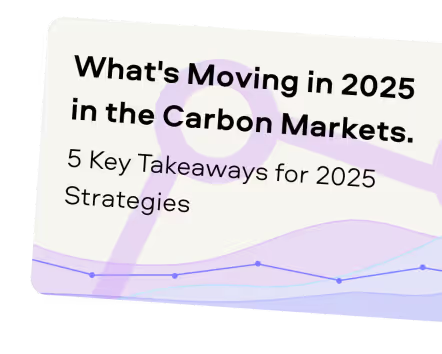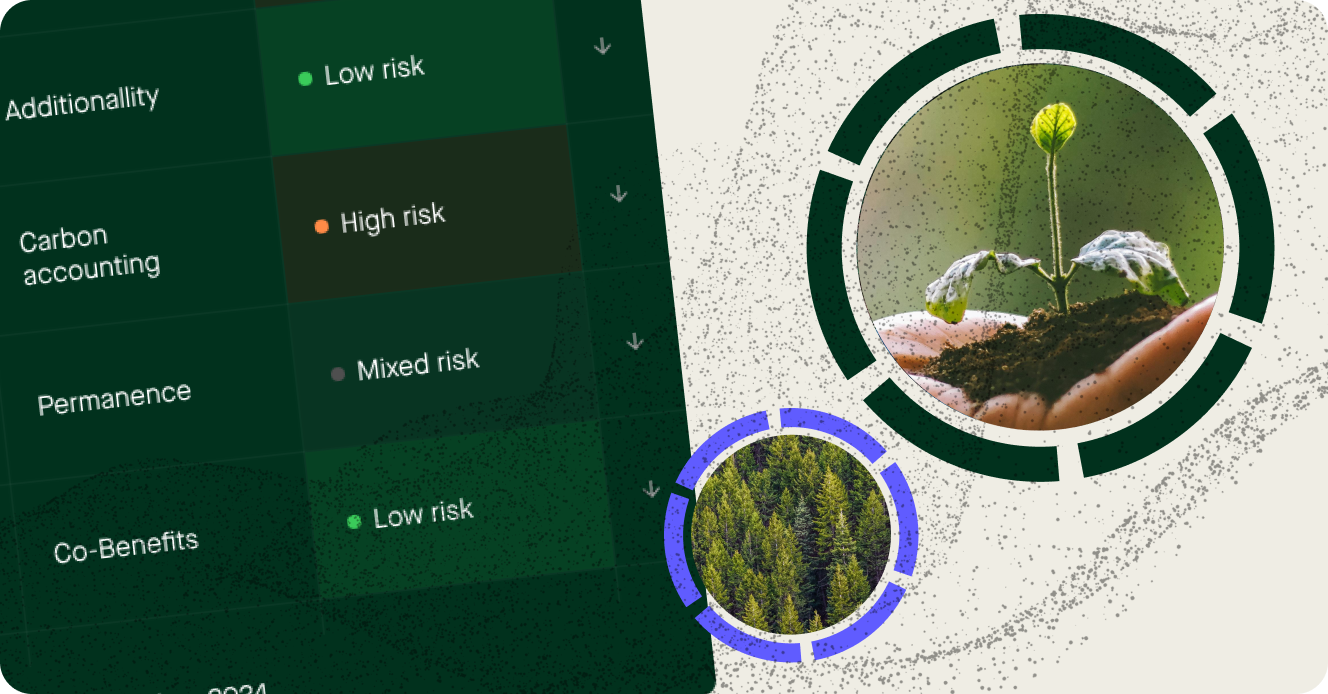“Over the years we’ve invested significantly in our field data team - focusing on producing trusted ratings. While this ensures the accuracy of our Ratings, it doesn’t allow the scale across the thousands of projects that buyers are considering.”
For more information on carbon credit procurement trends, read our "Key Takeaways for 2025" article. We share five, data-backed tips to improve your procurement strategy.

One more thing: Connect to Supply customers also get access to the rest of Sylvera's tools. That means you can easily see project ratings and evaluate an individual project's strengths, procure quality carbon credits, and even monitor project activity (particularly if you’ve invested at the pre-issuance stage.)
Book a free demo of Sylvera to see our platform's procurement and reporting features in action.
Many companies have embraced climate change initiatives. But do said initiatives actually remove greenhouse gases (GHGs) from the atmosphere and fight global warming?
This question has driven the need for high-integrity carbon credits.
The thing is, you can't guarantee high-integrity carbon credits without accurate forest biomass estimation models. After all, biomass estimations help predict how much carbon a nature-based project can sequester, which determines the number of carbon credits it generates.
Unfortunately, conventional biomass estimation methods, such as allometry and GEDI, fall short. That's why Sylvera developed Biomass Atlas - an innovative approach that uses proprietary multi-scale lidar data collected across 250,000+ hectares with deep ground-truthing. This leads to more accurate estimations in terms of aboveground biomass.
What does all this mean to you, the corporate buyer or investor? Accurate biomass estimations produce higher quality carbon credits, which have important market and financial implications.
Why forest aboveground biomass estimation accuracy matters in carbon markets
The term "biomass" refers to the standing dry mass, AKA dead matter, of woody plants.
It's usually expressed as a mass per unit area (e.g. Megagrams per hectare: Mg ha-1) and is used to determine the amount of carbon released and sequestered by forest ecosystems.
Put simply, we can use biomass estimations to determine the physical storage of carbon in wood. We can then use this figure to issue carbon credits for nature-based projects.
Of course, if we can't estimate forest aboveground biomass with reliable accuracy, we can't issue carbon credits for nature-based projects with reliable accuracy either. This could lead to multiple problems, such as over or under-crediting, a poor reputation in the marketplace for companies that purchase low-quality credits, and of course, likely less positive climate impact.
The problem with allometric and satellite-only models
There are multiple ways to estimate forest biomass. Some of the more popular methods use allometric and/or satellite-only models. But these methods are inherently flawed.
For one thing, allometric and satellite-only models rely on tree diameter, height, and species data from a maximum of 4,000 trees. Most models are built on far less. Why is this a problem? Because it doesn't provide an accurate estimation of trees, which leads to poor quality credits.
Just as problematic, these models apply biased assumptions across continents. For example, 35% of GEDI training data comes from the US and Europe, but only 12% comes from Africa and only 8% from Southeast Asia and Australia. These model accuracy issues make estimation of aboveground biomass more difficult.
Furthermore, satellite lidar, like what the entire GEDI program is based on, has very low data point density. For comparison, Sylvera's modeling strategy, which uses terrestrial, drone, and helicopter technology, collects 30-15,000x as many lidar data points per m2 as GEDI.
Biomass Atlas: Multi-scale lidar and real-world ground truthing
Sylvera's answer to these challenges is Biomass Atlas - the world's most accurate biomass data product, built on over $10 million in proprietary Multi-Scale LiDAR (MSL) field campaigns.
Unlike traditional methods, Biomass Atlas is not trained on satellite-only or third-party data. Our expert teams field-collected MSL data across 250,000+ hectares on 5 continents using three complementary lidar techniques:
- Terrestrial Laser Scanning (TLS): 3D-explicit modeling of individual trees at 1-hectare plots, with direct measurement of tree volume and biomass—no allometric equations required
- UAV Laser Scanning: RIEGL VUX-120 kinematic scanning at 100m altitude that upscales TLS measurements to tens of thousands of hectares while maintaining sub-meter accuracy
- Airborne Laser Scanning (ALS): Same system on helicopter at 160m altitude, providing wall-to-wall reference data at survey-grade accuracy
This approach has been validated through peer review and represents a fundamentally different methodology from legacy systems.
Where legacy models measure a maximum of 4,000 trees across 960 hectares, Biomass Atlas contains data from over 25,000 trees resulting in 450B+ highly valuable data points. The Sylvera database contains 150,000 datapoints per m2, while allometry databases only have three (height, diameter, and weight.)
The technology we use to scan trees is six times more accurate than the technology used by allometric and satellite-only models. And crucially, Biomass Atlas delivers:
- 30m resolution biomass and canopy height data
- Complete temporal coverage from 2000-present
- Annual updates (with quarterly updates starting Q1 2026)- Uncertainty estimates for every pixel
- Global wall-to-wall coverage across all forested regions
- Fast API delivery—data in hours, not months
Biomass Atlas has collected data from 80% of all NBS geographies across Africa, Latin America, Southeast Asia, and Australia, giving us an incredible foundation for accurate forest structure and aboveground biomass estimations.
Real-world validation of forest AGB estimation
So, how does this biomass data translate to real-world scenarios?
When cross-validating data in Peru, Gabon, and Mozambique, our team found that Sylvera's regional remote sensing data model was able to estimate biomass within 1.3% (Peru) and 3% (Gabon) and 2% (Mozambique) of the ground truth value. For these same areas, traditional model estimates were inaccurate by 16% (Peru), 39% (Gabon), and 17% (Mozambique).
Sylvera's AGB estimation model picked up 1.5-2.2x more carbon in the African grasslands of Mozambique than widely used models would suggest - which you can read more about in this Miombo Woodlands study.
Poor biomass estimation models costs the market
The truth is, under-informed model parameters lead to poor tropical forest biomass estimations.
When this happens, carbon credits are issued and priced incorrectly, which damages buyer trust. Even if the project developers who issued the miscredited projects had good intentions.
Over time, poor biomass estimations undermine the entire nature-based project category, which includes REDD+, ARR, IFM , and many others, making them less enticing to potential investors. This shrinks the pool of viable investments and reduces climate mitigation opportunities.
As you can see, model performance is essential. Sadly, most models aren't up to the task.
How to invest with confidence: what better data unlocks
Biomass Atlas estimates aboveground biomass with greater accuracy than any other model on the market.
Because of this, Sylvera customers can make more confident procurement decisions. After all, they have access to reliable data, which they can use to secure quality carbon credits on a consistent basis.
This benefits corporate buyers and investors in multiple ways. One, they get quality credits they can use to offset their own emissions or sell at a premium. Two, they maintain a good reputation in the marketplace because the credits they buy come from quality projects that slow the global carbon cycle. And three, they have peace of mind, knowing their actions make financial sense and improve the environment.
Whether you're a project developer seeking to secure financing faster, a registry building next-generation verification infrastructure, or a government establishing credible REDD+ baselines, Biomass Atlas provides the independent, defensible data that stakeholders demand.
Sylvera customers also benefit from post-issuance monitoring tools, so they can keep track of their investments, intervene when necessary, and maintain trust over time.
Request access to Biomass Atlas today to learn more about the world's most accurate biomass data, delivered via API in hours, not months.
In Conclusion
Not all forest aboveground biomass estimations are created equal.
This is important because data quality leads to credit quality. When you consistently buy or invest in quality carbon credits, you avoid fines and earn the public's trust.
Biomass Atlas - Sylvera's revolutionary biomass data product built on $10M+ in proprietary Multi-Scale LiDAR field research - eliminates bias, builds confidence, and drives real climate outcomes. Trusted by governments and recognized as the industry benchmark by registries like Equitable Earth Registry, it's quickly becoming the gold standard for forest biomass estimation.
Get access to Biomass Atlas now to see how accurate, defensible biomass data improves credit quality and accelerates project financing.





.png)



.jpg)





